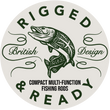Salt Cured Fishing Bait

How to Make Shelf-Stable Bait for Remote Adventures
Ever hiked or camped your way to a remote fishing spot only to realise your bait has gone off faster than a warm pint on a summer’s day? Or maybe you fancied a spur-of-the-moment cast just as every bait shop in a 30-mile radius slammed shut for the night? We’ve all been there—staring into a tackle box full of dreams and not a single decent bait in sight.
That’s where shelf-stable bait comes into play. Simple to make, cheap as chips, and a real game changer for sea anglers who like to roam. Using nothing more than a tub, some cheap salt, and a bit of patience, you can preserve a range of effective sea baits and keep them in your bag, truck, or backpack ready for whenever the urge to fish strikes.
This guide takes you through the process of salt cured fishing bait—a traditional preservation method that still holds strong in the modern world of sea fishing. Whether you're planning a week-long hike-in fishing adventure or just want a reliable backup stash in your kit, this method could be your best mate.
What Is Salt Curing?
Salt curing is an age-old method of preserving food (and bait) by drawing moisture out of it. In this case, it works by rem
oving the water from the bait’s tissue, essentially turning it into a firmer, longer-lasting version of itself. Done properly, salt-cured baits can last for weeks or even months without refrigeration.

Salt curing is an age old method of preserving foods.
Unlike frozen baits which require a cooler or power, salt-cured baits are shelf stable fishing bait—perfect for multi-day camping and fishing trips.
Best Baits to Preserve for Sea Fishing
Not all baits are suitable for salt curing, but the ones that are tend to be the heavy hitters in a sea angler’s arsenal.
✅ Fish Baits (must be filleted)
Mackerel – oily, attractive, and takes to curing well. A top choice.
Herring – another oily favourite. Make sure to fillet it before curing.
✅ Squid
Salt curing firms it up nicely, helping it stay on the hook better. Also great as tipping bait.
✅ Molluscs
Mussels and clams can be a bit fiddly but cure well and stay on the hook far better once salted.
✅ Worms
Black Lugworm and Ragworm both take to curing. The result is a leathery, scent-packed bait that resists nibbles and lasts longer.
What You’ll Need to Make Salt Cured Fishing Bait
The beauty of this method is in its simplicity. You don’t need fancy gear or specialist tools—just a few basic items:
A few plastic tubs with lids (takeaway containers work well)
A big bag of cheap salt (non-iodised rock salt or table salt is fine)
A knife (for filleting fish)
Some kitchen roll or newspaper (for drying off excess moisture)
Optional: A small bit of bait elastic for securing softer baits on the hook after curing.
Step-by-Step: How to Preserve Sea Fishing Bait with Salt

Step 1: Prepare the Bait
Fillet any fish baits first. Whole fish won’t cure properly, and guts can go rancid quickly. Clean any molluscs or worms of excess slime and grit. Pat everything dry with a bit of kitchen roll to remove surface moisture—it helps the salt work more effectively.
Step 2: First Layer of Salt
Add a thick layer of salt to the bottom of your plastic tub—about 1cm deep.
This is your foundation layer and helps prevent spoilage from the bottom up.
Step 3: Add the Bait
Place your prepared bait in a single layer on top of the salt. Make sure there's space between each bait and the sides of the tub so salt touches everything.
Step 4: Cover Completely
Now, pour salt over the top until the bait is completely covered.
The idea is to totally encase the bait in salt—no bits peeking out.
Step 5: Leave for at least 24hrs
Seal the tub and leave it in a cool, dry place for at least 24–48 hours. For softer baits like worms, a shorter cure (24 hours) will do. For fish fillets or squid, give it at least 48 hours. You’ll see moisture being drawn out, turning the salt damp, drain the brine off.
Step 6: Drain and Store
Once cured, remove the bait and shake off the excess salt. You can dry it briefly on kitchen paper, then store it in a clean dry tub with a bit of fresh dry salt or even just loosely in your tackle box. No need to refrigerate-just keep it cool and dry. Your bait is now preserved sea fishing bait and ready for adventure.
Storage Options & Handy Tips
One of the best things about salt-curing sea bait—especially fish baits like mackerel and herring—is how much tougher they become. Once they’ve firmed up from the salt and you’ve wrapped them onto a hook with a bit of bait elastic, they’re seriously durable. In fact, salt-cured fish baits are tougher than fresh ones, making them a cracking option for long-range casting.

Salt-cured bait is shelf-stable, long-lasting, and perfect for remote expeditions
If you have a vacuum sealer then pack your cured bait in these. Just keep a few things in mind:
Keep the edges dry – Any stray salt or moisture on the lip of the vacuum bag will stop it sealing properly.
Watch out for brine – Even after curing, some bait will still leach salty brine. Try to blot off excess brine before sealing, or you’ll find your sealer sucking up the contents like a snotty hoover—leaving you with a foul-smelling mess and a cleaner’s nightmare.
Label & portion – Seal baits into usable portions. No point opening a kilo of mackerel fillets when all you need is a handful.
Vac-sealed bait also packs flatter and stays protected in your rucksack or glove box, so it’s ideal for hikers, wild campers, and anyone who likes their bait to be as rugged as the coast they’re fishing.
Why Use Salt Cured Fishing Bait?

Salt curing make baits tougher, easier to hook and longer lasting.
Cured bait isn’t just for emergencies. It can actually out-fish fresh bait in certain situations:
Tough hookers: Salt curing firms up the flesh, making it harder for little pickers like pout or crabs to strip it quickly.
Long-range casting: Firmer baits survive a power cast without flying off the hook.
Scent trail: The curing process concentrates natural scent—sometimes giving you the edge when fishing over big distances or in rough seas.
They’re also brilliant for grab-and-go sessions, when bait shops are shut and the tide waits for no man.
Here’s a great video showing you how to cure sea fishing baits: https://youtu.be/BfRuev52qXE?si=Etmj2AJ1SFiker4p
Gear Tip: Rigged & Ready for Shore Fishing
Pair your salt cured bait with reliable kit like the Rigged & Ready S-MAX travel rod and the RR6000 reel. The S-MAX is a serious bit of gear for shore anglers—a compact, powerful rod that breaks down for travel but punches well above its weight when it comes to casting distance and playing strong fish. Combine that with the smooth, saltwater-ready RR6000 reel, and you’ve got the ideal setup for mobile sea angling, wherever you end up.

Check out this video showing the compact S-Max in use with salt cured baits on a packrafting adventure in Scotland: https://youtube.com/watch?v=rdYqZ6WBF5g&t=16s
Final Thoughts
Whether you're prepping for a remote coastal mission, keeping a stash of emergency bait in your glove box, or just looking to experiment with new tactics, salt curing your own fishing bait is a brilliant skill to have. It’s simple, affordable, and best of all—it works.
So next time you find a good deal on fresh bait, grab a few extras, cure them up, and stash them for the future. Your future self, halfway up a windswept cliff with no signal and no bait shop for 20 miles, will thank you.











